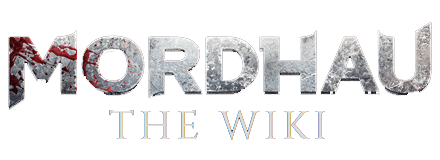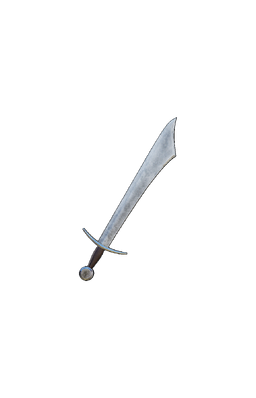| This article is a stub. You can help Mordhau Wiki by expanding it. |
The Falchion is a one-handed melee weapon, often used as a secondary backup weapon.
Overview[ | ]
Strengths[ | ]
- High strike damage, particularly against light and medium armor.
- Fairly fast attack speed.
- Good in tight confined spaced like doorways and hallways where you can rush down and kill multiple opponents with fast swings.
- Good drags similar to the Messer.
Weaknesses[ | ]
- Relatively low thrust damage.
- Below-average reach.
- Good indoors and in confined spaces but vulnerable and easily outranged in the open.
Skins / Components[ | ]
The Falchion has 3 skins: Default, Katzbalger, and Sullen.
| Component | Cost | ID | Color Set |
|---|
Historical References[ | ]
A falchion is a one-handed, single-edged sword of European origin. Falchions are found in different forms from around the 13th century up to and including the 16th century. In some versions, the falchion looks rather like the seax and later the sabre, and in other versions more like a machete with a crossguard.
The blade designs of falchions varied widely across the continent and over time. They almost always included a single edge with a slight curve on the blade towards the point on the end and most were also affixed with a quilloned crossguard for the hilt in the manner of the contemporary arming swords. Unlike the double-edged swords of Europe, few actual swords of this type have survived to the present day; fewer than a dozen specimens are currently known. A number of weapons superficially similar to the falchion existed in Western Europe, including the Messer, hanger and the backsword. Two basic types of falchion can be identified:
A falchion had a lower quality and status than the longer, more expensive swords, as almost none of them survive today. Falchions are sometimes misunderstood and thought of as being similar to machetes; however, the ancient falchions that have been discovered are very thin and on average, lighter than a double-edged blade. These weapons were therefore not cleaving or chopping weapons similar to the machete, but quick slashing weapons more similar to shamshir or sabres despite their wide blade. While falchions are commonly thought to be peasants' weapons this is not always the case; the Conyers falchion belonged to a landed family, and the falchion is shown in illustrations of combat between mounted knights.
Notes and Trivia[ | ]
- The Katzbalger skin for the falchion features a broad, double-edged blade with a rounded tip, but it doesn't change the weapon's statistics.

